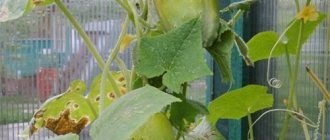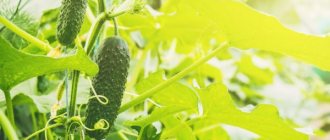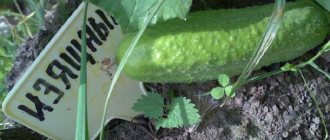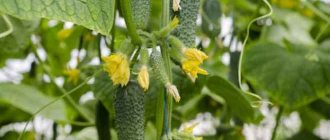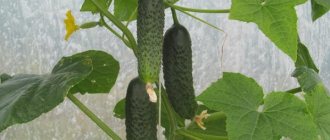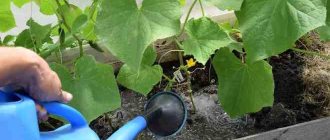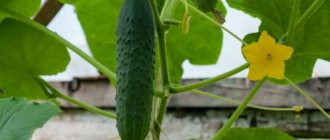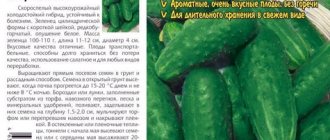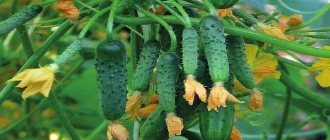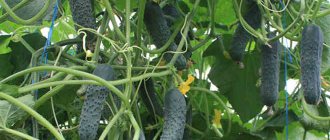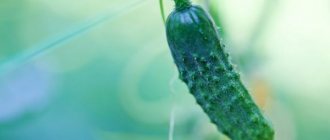When spring is in full swing, gardeners and farmers will need a high-yielding and strong hybrid of cucumbers more than ever. Pasamonte f1 is always productive and resilient, rarely gets sick and produces significant yields.
| Landing location | Ripening time | Mode of application | Fruit length | Group | Fruit smoothness | Pollination method |
| Universal | Early ripening (35-45 days) | Universal | Short (gherkins) - less than 10 cm | Hybrid | Highly lumpy | Parthenocarpic |
Harvest and storage
It is very important for the Pasamonte variety to collect cucumbers on time and at least 2 times a week, due to which the quality of the fruit will only increase and the fruiting period will extend.
The first harvest can be harvested from cucumber vines 40–42 days after planting the crop in the ground. The shelf life of vegetables is 10 days without loss of nutritional and commercial qualities. It is recommended to keep them in a dry, cool place or in the refrigerator. Recently, parthenocarpic varieties of cucumbers, including Pasamonte, have become increasingly popular among professional gardeners and beginners. The hybrid is disease-resistant, easy to care for, bears fruit abundantly, cucumbers have a good taste and are widely used in cooking.
Characteristics of Pasamonte cucumber
Cucumber is one of the most popular vegetable crops, but choosing seeds for planting is not so easy even for experienced farmers. The Pasamonte cucumber has a hybrid origin, which allows it to be grown even in unfavorable conditions.
Characteristics of Pasamonte cucumber
The species has good resistance to drought and various diseases. The fruits have a good presentation and pronounced taste.
Cucumber Pasamonte F1
Pasamonte is an early, high-yielding cucumber hybrid created by the Dutch company Syngenta. Recommended for cultivation in open and closed ground (greenhouses and greenhouses). It is advisable to grow in home gardens, garden plots and small farms. The rooted hybrid does not require the help of bees to pollinate flowers. From germination to the start of fruiting it takes only 40-42 days.
Plants grow medium-sized, strong and medium-branched. The leaves are green in color and come in medium to large sizes. The leaf axil contains 2-3 ovaries. This variety is famous for the appearance of an increased number of ovaries.
The fruits are not ribbed, have a regular cylindrical shape, with large tubercles. Length is 6-9 cm, weight 70-120 cm.
The skin is dark green and contains light stripes that reach the middle of the fruit. The spikes are white. Consumers note the dense flesh, without bitterness. The marketable yield is 270-330 c/ha. The yield of commercial products is at a high level and amounts to 94-98%.
A variety of universal consumption. The taste in salads is average, but very high in pickles and preserves.
The hybrid has a high degree of protection at the genetic level against cladosporiosis, and is relatively resistant to cucumber mosaic virus and powdery mildew.
The main advantages of the Pasamonte cucumber include:
Resistance to several cucumber diseases;
- Marketable condition;
- The versatility of the fruit;
- High taste qualities;
- Early ripeness;
Advantages and disadvantages
An early-ripening parthenocarpic hybrid of the gherkin type from Dutch selection with a bunched ovary arrangement has a sufficient number of advantages, thanks to which it enjoys increased attention among gardeners and small farmers:
- has complex resistance to major cucumber diseases;
- the hybrid is self-pollinating and does not require insects;
- early ripening and very high-yielding;
- genetically without bitterness, with high taste;
- the ratio of the length of the greenery to its width is 3:1, high color intensity and excellent marketable appearance;
- cultivation for the purpose of producing gherkins;
- possibility of universal use;
- Greens stop growing when they reach optimal size at the stage of harvest maturity.
When cultivating the hybrid form "Pasamonte-f1", it is necessary to take into account the susceptibility to downy mildew.
Growing technology
Hybrid early-ripening cucumber "Pasamonte f1" is most often grown on ridges in open ground, so care includes the following measures:
Watering plants. Before flowering, watering should be moderate, so it is enough to carry out irrigation activities once a week. During the active fruiting phase, watering with warm water is carried out daily or every other day, depending on temperature conditions and soil type.
Feeding. It should be carried out when flowering appears, using 100% mineral fertilizers or fresh mullein. The variety is responsive to combining watering three times a month with fertilizing based on a liter of manure or 10 g of urea per bucket of warm water.
Weeding and loosening
To improve the aeration parameters of the soil, it is recommended to regularly carefully loosen the soil or mulch the cucumber beds after weeding.
When growing, you can use both the wings and the trellis method. When grown using a trellis method, denser planting is allowed, but without excessively dense plants. It is recommended to form plants into one stem.
It is very important to carry out timely harvesting of green plants, as their overgrowth shortens the fruiting period and reduces the quality of the fruits
High-yielding early Dutch cucumbers "Pasadena f1"
The Pasadena f1 cucumber was bred by Dutch breeders. This mid-early parthenocarpic hybrid is capable of long-term fruiting, and the main harvest is formed by plants on the 48-50th day after the appearance of mass shoots.
The hybrid is included in the State Register of Russia and is recommended for cultivation in the Central and Middle Volga regions. The variety is in demand for cultivation in garden plots, homesteads and small farms.
Characteristics of the variety
The hybrid cucumber “Pasadena f1” is intended for fresh consumption, as well as for pickling and canning. Parthenocarpic cucumber has a high degree of resistance to cladosporiosis, and also has relative immunity to powdery mildew and cucumber mosaic virus.
The bushes are fast-growing, well-leafed, with a predominantly female type of flowering. The average length of a ripe fruit can vary from 6 cm to 9 cm. The fruits are cylindrical in shape, with a pronounced tuberculate surface. The average weight of the fruit is 65-95 g. The pulp has no bitterness and voids. Taste and product indicators are very high. The total yield, depending on the type of soil and quality of care, is about 11-14 kg per square meter.
Landing rules
Cucumber variety "Pasadena f1" is suitable for growing in open and closed ground. Seeds should be sown after the threat of frost and after the soil has warmed to a depth of 10 cm to 10-12°C. The standard sowing scheme for prepared seed material is 3-5 plants per square meter.
One of the primary sources of fungal, bacterial and viral diseases of cucumber in home gardens is the use of infected seeds for planting. Description of the variety, rules for pre-sowing preparation of seed material, as well as features of direct sowing and seedling cultivation from the originator Syngenta are as follows:
- seeds of this variety are sold after treatment with the fungicide “Tiram”, therefore, when planting, the seed should not be soaked or subjected to additional treatment;
- planting cucumber seedlings is an excellent way to significantly speed up the emergence of vegetable seedlings, as well as the harvest;
- cucumber seeds are sown when the temperature of the soil at a depth of 10-12 cm is approximately 12-14 ° C, and also when the risk of return frosts has passed at the time of germination;
- when planting on ridges of open ground, it is recommended to add 500 grams of manure or humus, supplemented with wood ash, to each planting hole;
- seeds are sown to a depth of 1-2 cm according to the standard planting pattern of 30x60 cm.
Growing technology
Cucumbers of the Pasadena f1 variety are responsive to proper care measures at all stages of the growing season:
- at the initial stage of the growing season, watering is carried out once every 2-3 days, and approximately 7 liters of warm water are required for each square meter;
- at the budding stage, watering should be reduced, and the previous frequency of irrigation measures will be required for cucumbers only during the phase of mass formation of greens;
- in the first two weeks, cucumbers need increased nutrition with nitrogen-containing fertilizers, and at the flowering stage, nitrogen fertilizers should be replaced with phosphorus;
- in case of insufficient flowering, it is advisable to feed the cucumbers with potassium-phosphorus fertilizers, and high efficiency was noted when applying additional fertilizing based on urea and humus;
- temperature conditions are very important for cucumbers, so during the fruiting phase the temperature should be 18-24°C.
Cucumbers have proven themselves very well when grown on vertical trellises.
In addition, it is important to use the pinching method. The formation of cucumber bushes should begin after 6-8 leaves appear on the plant.
Description of the variety
The bushes are medium-sized, well-leafed with light green and green leaves. The plant is medium-climbing, with at least two ovaries formed at each node. The hybrid is parthenocarpic and early ripening, so high yield occurs 43-45 days after germination.
The harvested crop can be used both fresh and for canning. The hybrid form has sufficient disease resistance and is resistant to cladosporiosis. It is characterized by relative resistance to powdery mildew and cucumber mosaic virus.
The length of greens can be 6-9 cm, the surface is coarsely tuberous. The fruits are cylindrical in shape, weighing from 67 to 120 g. The pulp is very tender and tasty, without voids or bitterness. The total yield, subject to agricultural technology and favorable weather conditions, reaches 12-15 kg per square meter.
Hybrid cucumbers "Pasamonte f1"
Pasamonte is a Dutch hybrid cucumber variety characterized by high yield. Added to the state register for the Middle Volga and Central districts. Growing Pasamonte is allowed in open ground or in greenhouse conditions.
The fruits are cylindrical, not very ribbed, but with large tubercles. The weight of one greens is 70-120 grams, and its length is 6=9 centimeters. The cucumbers are dark green in color, with faint white stripes and spots, reaching approximately to the middle of the fruit. The thorns on cucumbers are white and the seeds are small. Greens are not prone to overgrowing.
Pasamonte F1 has high taste characteristics. These cucumbers have no bitterness, the flesh is dense and crispy. Thanks to this, the Pasamonte variety can be used for any purpose. Cucumbers will be good in fresh summer salads, as well as in winter preparations. Pasamonte is ideal for salting and pickling. Cucumbers have a beautiful presentation, so they are grown for sale in small private greenhouses.
https://youtube.com/watch?v=PqHY1U7bu1g
The hybrid is susceptible to downy mildew, and its susceptibility to bacteriosis is average.
Pasamonte cucumbers are planted in open ground or unheated greenhouses at the end of May. You can use the seedling method or sow the seeds directly. The seedlings should be 25-35 days old, and the seeds should be pre-soaked for a day in a vermicompost solution. Planting density is 3-4 bushes per square meter. The seeds deepen no more than 1.5-2 centimeters.
Pasamonte F1 produces stable yields no matter what kind of summer it is. Therefore, many gardeners choose seeds of this particular variety for sowing.
https://fermoved.ru/ogurtsyi/pasamonte-opisanie-sorta.htmlhttps://agrouchastok.ru/ovoshhi/ogurcy/pasamonte-f1-opisanie-otzyvy.htmlhttps://pomidorchik.com/ogurec/sorta/pasamonte- f1.html
Pasadena – cucumber plant variety
Information on the admission of the Pasadena Cucumber from the Register of the State Variety Commission of the Russian Federation
Application for admission No. 29679, registered 1996-04-04. The Pasadena Cucumber variety was included in the register of approved varieties in 1998. Approved for use in the regions: Central, Middle Volga.
The originator of the Pasadena Cucumber variety is:
SYNGENTA SEEDS BV (WESTEINDE 62, PO BOX 2, 1600 AA ENKHUIZEN THE NETHERLANDS)
Question to the portal experts
If you haven't found the answer to a question, don't hesitate to ask an expert.
Have you already planted Pasadena Cucumber?
Tell us if you liked this variety? Will you plant it again?
Register or Login so you don't have to enter your Name and Email every time
Thanks for the comment! It will be published after checking by a moderator!
No comments yet, be the first!
A portal for those who love their dacha
Your question has been sent for moderation. Don't worry, we quickly check your questions and your question will be answered within 1 day.
We have noticed that you are already registered on our website. We recommend that you log in to view the created question.
If you don't remember your password, you can recover it.
You were not registered until today, so we have registered you. Your password has been sent to your specified mailbox.
Growing cucumbers - the difference between varieties and hybrids
Cucumber hybrids are better...
And last year I planted Chinese for the first time and was very pleased.. Variety
An interesting feature of this variety is the transformation of greens into “lemons”. As the testes ripen, they take on the shape and color of a real lemon, you can’t tell the difference - that’s where the second name of the variety comes from. So, “Lemon” is a stable variety of cucumbers with spherical and round-ovoid fruits, producing 8-10 kg of amazing fruits per plant per season and bearing fruit until frost. This is not a hybrid, it is pollinated by insects.
However, it is necessary to water more abundantly
Elena Karnakova, Irkutsk I have been gardening for This season I will certainly continue my experiments with cucumbers; I have already started them in the very early spring. I’ll grow a few at home so I can take cuttings from them early.
As soon as the cucumbers planted in the garden grew, I removed all the stepsons in the axils up to the fifth node (this is the most reliable way to increase productivity). I threw the “clippings” into the compost pile, but left a few cuttings in a bucket of water. And what? Less than two weeks later, their roots grew.
We have a large greenhouse, and I buy a lot of seeds, but every year they are more and more expensive, and their number in bags decreases - it’s good if there are 10-12, or even 5-7 pieces. Just a mockery!
Cucumbers - by cuttings!
And my attitude towards hybrid seeds changed radically, especially when parthenocarpic, female-flowering cucumber hybrids that did not require pollination appeared. I immediately felt that their yield was higher and their taste was excellent. If the summer is cool and rainy, the greenhouse is closed, and the bees are not flying, we still have a good harvest. Therefore, for the last few years I have been buying only self-pollinating cucumbers.
Some summer residents are distrustful of cucumber hybrids: they say they are “not real.” Tolley’s business is, as they say, grandfather’s. Well, the time has come to put all the dots where they need to be, and at the same time decide on the benefits. Where would the garden beds be without it?
I'll wait. Will you be planting Chinese seedlings?
The first harvest was at the end of May... you could already eat your own. Sweet, crunchy and small seeds
"White Angel"
White cucumbers
You need to water not occasionally, but constantly
Lack of moisture, if constant watering is not possible, then place the bottles and pull a cloth made of synthetic material, such as crimplen, under the root, the ground can be mulched with sawdust to reduce moisture evaporation!!!;))))))
And I will definitely try the purchased domestic varieties
Since the cucumbers had just begun to bear fruit, there was no empty space in the greenhouse for cuttings. I planted them outside and covered the top with five-liter bottles with the bottom cut off. Almost all of them took root well, but grew slowly. Apparently, because in the open ground. In Siberia, the heat during the day is terrible, but the nights are cold. And cucumbers are so sissy!
In the spring, you want to plant early, but the ground is still cold, so it happens that they don’t sprout. Then you have to buy additional seed material. Our autumn (unlike spring - yes, this is such a paradox) is usually warm, but by this time cucumbers often already wither or are affected by spider mites.
I especially liked the varieties I’ll tell you Previously, for example, I did not notice the difference between ordinary varieties and hybrid ones, preferring those that can be grown with my own seeds. But one day I planted a Parisian gherkin and simply fell in love with it (and after me, so did all my household). This is how my passion for pickles began, i.e., scientifically speaking, tiny cucumbers one or two days old.
In general, I usually sow all the cucumbers directly into the ground, under the film, as soon as the conditions allow - there is always not enough space for seedlings. But this year I’m thinking of at least sowing the earliest ones (the same April and Chinese snakes) in peat pots for seedlings. I really want to enjoy cucumbers early)))
has the appropriate coloring of the skin and spines. Moreover, the harvest is never bitter. This hybrid was planned to be grown in greenhouses, but as practice has shown, vegetables grow well in open ground right in the beds. They can be eaten both canned and fresh.
vsaduidoma.com
How to grow a hybrid yourself
Pasamonte cucumbers are grown through seedlings and sowing in open ground. Caring for the crop is standard and requires compliance with the watering and fertilizing schedule, loosening and weeding of the area.
Planting by seedlings
The seedling method of growing cucumbers significantly reduces the ripening time. Even in open ground, the harvest begins two weeks earlier compared to cucumbers grown in a greenhouse using direct sowing.
Hybrid seeds do not require pre-sowing disinfection or soaking with growth stimulants. The seed material is processed in production.
To grow strong and healthy seedlings, use nutritious soil: 1 part sawdust, 2 parts peat and humus. Add 2 tbsp to a 10 liter bucket. l. ash and 1.5 tbsp. l. nitrophoska.
The mixture is thoroughly mixed and distributed into plastic or peat containers to the top. Seeds are planted to a depth of 1-2 cm, 1 piece each. into each container and water with warm, settled water.
At the stage of 2-3 true leaves, seedlings are fed with a nutrient solution: 3 tsp. nitrophoska (nitroammofoski) per 3 liters of warm water. Seedlings need to be watered abundantly, once every seven days.
After 27–32 days, the seedlings will be ready to “relocate” to a permanent location.
Holes with a depth of 10-15 cm are formed on the site, boiling water is poured over it and seedlings are planted at a distance of 50–60 cm.
Direct sowing into soil
Cucumbers are hypersensitive to cold, so for rapid germination the soil must warm up to at least +14 °C, and the air - up to +22 °C. The best time for sowing is the last ten days of May. The culture prefers light and nutritious soil from a mixture of turf, sawdust, humus and peat (1:1:1:1).
The site for sowing is chosen on the south side. The soil is dug up before winter, fertilized with humus and watered with a solution of copper sulfate (1 tsp per 3 liters of water). The seeds are planted with the narrow part down, 2 pieces at a time, to a depth of 2-3 cm with an interval of 10 cm. Next, the soil is watered generously with warm, settled water.
The area is covered with polyethylene or agrofibre to protect it from night frosts. The seeds hatch in 6–8 days.
Important! When planting, the main principle of crop rotation is observed - do not grow cucumbers in the same place year after year.
Growing and care
It is not advisable to cultivate cucumber crops near plantings of tomatoes, radishes and radishes. Healthy neighbors are dill, beans, peas, garlic, cabbage, beets, and onions.
Basic rules for successful cucumber farming:
- Loosening the beds after each watering and removing weeds. The procedure is carried out carefully, trying not to catch the roots located close to the surface of the earth.
- Mulching the soil with sawdust or peat will help reduce the amount of weeding.
- Before flowering, moderate watering is provided - once every 7 days. During the fruiting period, plants are watered at the root daily.
- Pruning of the vines is carried out during the period of rapid growth, forming the plant into one stem.
- The culture is responsive to regular feeding. In total, 4-5 portions of fertilizer are applied during the growing season.
Scheme for feeding cucumbers:
- before flowering – 1 tsp. urea and superphosphate, 1 tbsp. l. sodium humate per 10 l;
- during the fruiting period - 1 tbsp. l. nitrophoska, 20 g of chicken manure per 10 liters of water;
- subsequent feedings (every two weeks) – 1 tsp. potassium sulfate, 500 ml mullein per 10 liters of water.
Instead of fertilizers prepared independently, they use ready-made humic fertilizers “Breadwinner”, “Ideal”, “Fertility”.
Features of cultivation and possible difficulties
The agricultural technology of Pasamonte cucumbers does not differ significantly from the cultivation of other hybrids.
Vigorous plants require vertical tying to a trellis.
Cucumbers are planted behind curtain crops (sunflowers, corn) for protection from cold winds and scorching sun rays. Tall crops act as a kind of wall, behind which cucumbers feel comfortable and begin to bear fruit several days earlier.
Reference. Wing crops are sown perpendicular to the direction of the dominant winds 6–10 days before sowing or planting cucumbers.
Diseases and pests
The hybrid is immune to brown spot and cucumber mosaic and is absolutely immune to bacteriosis, powdery mildew, and gray rot of roots.
Treatment of plants with chemicals delays the fruiting of the crop. In the fight against fungi and bacteria, prevention and treatment with organic and mineral compounds are effective.
Signs of powdery mildew:
- white-yellow coating on stems and leaves;
- small brown balls (spores);
- drops of dew on greenery;
- dry leaves, curled upward;
- rot on cucumbers.
Treatment:
- A liter of curdled milk, whey or kefir per 10 liters of water. The number of treatments is not limited.
- Per liter of water 1/3 tsp. soda ash, 25 ml of liquid soap. Treat once every seven days.
- A liter jar of wood ash for 5 liters of boiling water. Leave for 24 hours, spray the bushes once every seven days.
Signs of gray rot:
- gray-brown slippery spots on stems and leaves;
- gray, indefinitely shaped spots on fruits;
- the appearance of watery gray fluff on the fruit.
For safe treatment, use the Trichodermin suspension. For irrigation, 100 ml of the drug is diluted in 10 liters. In case of severe damage, plants are treated up to 5 times a week. To prevent gray rot, before planting in the ground, the roots are dipped in a mixture of 5 liters of water, two parts of soil, one part of humus, 5 g of suspension. After two leaves appear, the seedlings are treated every two weeks.
Signs of bacteriosis:
- yellow-brown spots on cotyledon leaves with a characteristic angular shape;
- mucus from the back of the leaves;
- leaf perforation.
Treatment:
- Infuse 100 g of onion peels in 1 liter of boiling water. After 48 hours, strain the solution and dilute with water in a ratio of 1:5. Treat bushes once every 10 days after sunset.
- For 10 liters of water 1 tsp. boric alcohol and brilliant green, spray the plants once every 20 days.
Disease prevention measures:
- periodic treatment with Trichopolum (2 tablets per 1 liter of water);
- moisture level control;
- compliance with crop rotation;
- removing wilted and dry leaves;
- removing 3–5 cm of soil and removing plant debris at the end of the season;
- timely feeding;
- loosening the soil;
- choosing a sunny place for planting;
- treatment of the plot with "Gamair" before sowing;
- reduction of nitrogen in the soil;
- thinning of plantings.
Spider mites and slugs pose a particular danger to cucumbers. For prevention, the soil is dug up in the fall and left to freeze.
Folk remedies against spider mites:
- grind 1 kg of aloe vera through a meat grinder, pour in 10 liters of water and mix in 50 g of laundry soap shavings;
- pour 300 g of horse sorrel into 10 liters of water, leave for 3–5 hours;
- Pour 50 g of greens and dandelion flowers into 2 liters of water and leave for 3-4 hours.
Processing frequency is once every two weeks.
Folk remedies against slugs:
- Mix equal parts ground black pepper, wood ash and rock salt. Sprinkle the mixture into the beds and loosen.
- Dig furrows around the perimeter of the beds and pour ash and tobacco dust into them in equal parts.
- Mulch the soil with crushed eggshells, pine needles, sawdust, and river sand. Slugs do not like to crawl on such surfaces; sharp particles cut their abdomen.
- Prepare a solution of 1 liter of water and 2 tbsp. l. ammonia. Spray the bushes at night.
Bush care
F1 series hybrids have minimal care requirements. However, for high yields, plants should be provided with proper conditions. This variety needs the following:
- watering;
- fertilizer;
- hilling and trimming weaving.
Watering
It is better not to overwater this variety.
The watering regime is regulated depending on the stage of vegetation. Before the formation of flowers, 5 liters of water per 1 m² should be added in case of drought and 2 liters in case of precipitation. During the formation of greens, the plant requires more moisture, so the norm increases to 8 liters in dry weather and 6 liters after rain.
This variety tolerates drought better than excess moisture. Frequent irrigation can lead to rotting of the root system.
Pasamonte cucumbers also experience discomfort when an earthen crust forms after watering. To avoid problems with plant development, you should hill up the area after irrigation.
In this case, extreme caution must be taken, since the root system of cucumbers comes close to the surface of the earth. It is also better to water in the morning with warm water, since the variety does not tolerate cold well.
Fertilizer
Organic fertilizers should be used as fertilizer. Some mineral complexes can be prepared at home:
- serum solution with added iodine;
- onion infusion;
- fresh mullein or diluted chicken droppings.
The optimal way to apply fertilizers is to dilute nutrients in water for irrigation. Typically, urea is used as a top dressing for cucumbers in proportions of 10 g per 10 liters of water.
Trimming
Bushes of this variety need adjustment due to rapid growth. Excess lateral sprouts can cause deformation of greens due to lack of sunlight.
The vines are pruned during the active growing season. In this case, it is necessary to preserve the main stem and initial shoots.
Disease and pest control
The Pasamonte variety resists powdery mildew, cucumber mosaic virus, brown spot, but is not resistant to diseases and pests such as:
- whiteflies - insects that feed on plant sap, cause great damage to the crop, as a result of which cucumber bushes weaken and dry out. You can fight them with the help of garlic tincture (pour 100 g of chopped garlic into 0.5 liters of water, leave for 5 days, dilute in water in a ratio of 5 g of tincture per 1 liter of water), Actellik preparations (2 ml per 2 liters of water) , “Fufanon” (5 ml per 5 liters of water), “Confidor” (1 g per 10 liters of water), etc.;
- root-knot nematodes are pests that devour the root part of the plant and destroy large quantities of the crop. In preventative measures, you need to adhere to crop rotation, dig up the soil, and burn affected plants. Chemical agents that counteract nematodes include: “Metarizin” (500 ml per 10 liters of water), “Fitohit”, “Pecilomycin”;
- downy mildew is a fungal disease that occurs in the form of light spots appearing on leaves or stems, which darken over time, resulting in the death of the plant. Greenhouse cucumbers are most often affected. The most effective remedies are “Profit” (6 g per 5–10 l of water) and “Ridomil Gold” (25 g per 5–6 l of water), you can use an infusion of onion peels (pour 250–300 g of onion peel into 10 l of water, infuse 2–3 days);
- bacteriosis is a disease that develops during high air humidity and leads to rotting of bushes. Can completely destroy the entire crop. To avoid this, it is necessary to regularly ventilate greenhouses, loosen the soil, and prevent it from becoming waterlogged. You can also use the preparations “Ridomil Gold”, “Metaxil” (25 g per 5 l of water), “Etafol” - (10–20 g per 10 l of water);
- gray rot - affects the plant and fruits of cucumbers in the form of a gray coating, which leads to rotting and death of the bushes. Effective methods of control are Bordeaux mixture (20 g per 5 l of water), a solution of chalk and water (1:1 ratio), the drug "Rovral" (1% solution), "Hom" (40 g per 10 l of water), "Bayleton" "(1 g per 1 liter of water).
When using any chemicals to combat pests and diseases, be sure to follow the instructions for their use.
Cucumbers, unusual color
Then I got Dutch
The same thing... straight into the ground. And I planted Chinese seedlings in a greenhouse at the end of April
This variety somehow caught my eye in a seed store about 4 years ago and I was “on fire” to grow such white cucumbers.
Varieties with unusual white fruits:
We are accustomed to the fact that absolutely all varieties of cucumbers are colored in different shades of green. However, there is an exception to every rule and there are several unusual varieties that have a different colorNot enough moisture
.But the most important thing is that cucumbers from cuttings grow much faster than from seeds.I know that many people sow cucumbers in three periods to prolong fruiting: in spring, at the very beginning of summer and in July. But somehow this method doesn’t appeal to me. In the summer, the weather is usually hot, and the seedlings in cups and boxes dry out quickly, making it difficult to monitor the soil moisture. And I don’t want to bother with all this “winter fun” in the heat anymore.
. I definitely grow about a dozen Chinese long ones. They are very productive, and also hardy, and they make especially tasty winter salads.
Othello F1, Levo F1 and Parifin F1
Marina, I found a notebook, and out of habit I stick seed bags into it. I grew this variety and didn’t like it
Yes, these white cucumbers (also the variety that I chose), even from the photograph, you can see that they are more of a salad type than a pickling one. But the lack of aroma, of course, is upsetting - this is perhaps the best thing about cucumbers :)) And many people praise the “Chinese”. I usually plant April from the early long-fruited ones, but when it outgrows, its skin “tans” and it becomes more like a zucchini)) Chinese ones, according to reviews, do not have this drawback, but according to your observations?
Marina, Nekrasovskoe
What can I say... unusually pleasant appearance... I didn’t like it when pickled, but it was very... very small seeds and thin skin.
Natasha, Russia
Snow Leopard, Snow White, Bride
Marina, Nekrasovskoe
Lemon Cucumber (or Crystal Apple)
Natasha, Russia
Perhaps this is a variety - they are called salad varieties and are not suitable for pickling.
Marina, Nekrasovskoe
I would like to hope that they will turn out to be no worse than the Dutch ones.
Natasha, Russia
And these “newbies” bore fruit for me until the first frost. In my opinion, this is simply a wonderful result. In addition, hybrid cucumbers cannot be propagated by seeds, but plants bred by cuttings retain their properties.
Marina, Nekrasovskoe
Last summer I decided to try growing seedlings in an unusual way for cucumbers - by cuttings. To be honest, I didn’t expect success, knowing how poorly cucumbers tolerate transplantation. I’ve known for a long time that tomatoes quickly grow roots in water, but for cucumbers to be propagated in a similar way... But it’s interesting to try!
Natasha, Russia
Related link: New and best varieties of cucumbers for pickling, pickling and salad
OKSANA, Berdyansk
. Of course, out of habit, I looked at them with suspicion at first, but they literally turned out to be great cucumbers.
Natasha, Russia
And the white variety I had was not Chinese, but I still wasn’t impressed
7dach.ru
According to my observations, it’s exactly the same. When these cucumbers first started growing, of course they didn’t stay on the bush and didn’t have time to outgrow. But later... you just pick it, cut it into a big plate for the whole family, and the others hang around and begin to outgrow. They increase in length and diameter, but the skin remains just as tender, the seeds are small and SWEET!!!!.. Well, I’m writing all about one variety, I don’t know how other Chinese ones behave))
- The most delicious varieties of cucumbers reviews
- The most productive cucumbers reviews
- Cucumber varieties reviews
- Fertilizer for cucumbers at home
- Diseases and care of cucumbers
- New productive variety of cucumbers
- Cucumber seedlings in an egg
- Planting cucumbers in pots
- Pests of cucumbers
- Cucumbers disease care
- Cucumbers pinching
- Diseases in cucumbers
Planting and care
“Pasamonte” cucumbers are planted in unheated greenhouses or in open ground at the end of May or at the beginning of June, at night temperatures not lower than 15 C.
It is necessary to collect fruits regularly - at least twice a week.
Priming
To grow vegetables, choose well-lit, sun-warmed areas with fertile soil. You can sow the seeds yourself or use the seedling method.
The soil for planting is first dug up, manure and mineral fertilizers are added.
Sowing
Seedlings for planting should be 25-35 days old and have several leaves. The sowing density is no more than 3-5 bushes per square meter, the sowing depth is one and a half to two centimeters.
When planting seeds, they must first be soaked for a day in a solution of vermicompost, and also warmed up.
At first, planted cucumbers need to be protected from nighttime drops in temperature using film cover. The film can be replaced by any other non-woven material that is highly permeable to air, water and light, but protects against cold weather.
Watering
Caring for a hybrid grown in open ground includes:
- Feeding. Mineral fertilizers or fresh manure are used for fertilizing. A bucket of water will require 10 g of urea or a liter of manure. Feeding is carried out exclusively in the evening, 3-4 times a month.
- Watering. Before the plants bloom, it is enough to water them weekly. At the fruiting stage, the beds need to be watered once every 2-3 days, and during the hot period - daily or every other day. Water for irrigation should be warm.
- Weeding and loosening. To improve the aeration parameters of the soil, it is necessary to weed the plants daily and then carefully loosen the soil.
Landing rules
For growing cucumbers, areas are allocated that are well lit and warmed by the sun's rays, and are also provided with fertile soil. Further rules for planting hybrid cucumbers are as follows:
- before winter, the soil must be dug up, with the simultaneous application of manure and basic mineral fertilizers;
- Before planting in open ground, the seed material is heated and necessarily treated with special compounds;
- sowing cucumber seeds directly into the garden bed or planting pre-grown seedlings, but not before warming the soil and air to optimal temperatures;
- the best time for planting cucumbers in the ground is the last days of May, when night temperatures no longer fall below 15-17 °C;
- standard sowing and planting scheme: no more than 3-5 plants per square meter or 20x100 cm, sowing depth 1.5-2.0 cm;
- During planting, seedlings should have 3-4 true leaves, that is, the age of the cucumbers should be at least 2-3 weeks.
It is recommended to provide crops or planted plants with protection from cold weather during the first days, using film cover and standard arcs. You can replace the film with a non-woven covering material that allows light, air and water to pass through, but effectively protects plants from low temperatures.
Sowing and agrotechnics of cultivation
The Pasamonte variety is intended for planting in open ground or in greenhouses, using seedlings or directly with seeds. The main requirements for optimal cultivation of cucumbers are:
- loose, light soil, rich in nutrients, loamy or sandy loam, without stagnant water;
- night air temperature should not be lower than +15°C;
- the predecessors of cucumbers in the garden can be: potatoes, tomatoes, cabbage, legumes;
- the land is cleared of debris and weeds in advance (preferably before winter), deeply dug up, fertilized with manure (6–9 kg per 1 m²), wood ash (200 g per 1 m²) or mineral fertilizers.
Did you know? Cucumber
“discovered” more than 6 thousand years ago, and its homeland is India and the Himalayas.
To grow seedlings you need:
- disinfect the seeds in a weak solution of potassium permanganate (25–30 minutes);
- rinse the seed with water and soak, wrapped in a moistened napkin for 1 day;
- to speed up germination, you can use a growth stimulator;
- harden the seeds by placing them on the bottom shelf of the refrigerator for two days;
- you can plant the seeds in separate containers (peat glass, tablet) for convenient replanting in the ground;
- Seedlings should germinate at a temperature of +27°C; after the first leaves appear, reduce the temperature to +21…+23°C;
- seedlings can be transplanted into the ground after 3–5 true leaves appear, having previously hardened it for 7 days in a cooler room or outdoors.
If the seeds are sown directly into the ground, then it is also advisable to germinate them, harden them and plant them in well-warmed soil (+15°C)
In the open ground
The Pasamonte variety is planted in the garden in the second half of May, when the air temperature rises to +17°C at night and to +20°C during the day. The place should be bright, sunny, windless. The scheme for sowing or planting in a garden bed is that it is recommended to plant from 3 to 4 plants per 1 m², the sowing depth is 1.5–2 cm.
In the greenhouse
The scheme for planting cucumbers in greenhouses is that you need to leave a distance of 30–35 cm between the bushes, and 60 cm between the rows. The room temperature should not be lower than +15°C. The greenhouse should be well ventilated, but there should be no drafts. The land for planting must be prepared in advance: dug up and fertilized.
Agricultural technology and proper cultivation
"Passamonte" adapts to any growing conditions. Nominal performance can be achieved both when grown in small private greenhouses and when cultivated in industrial quantities.
Imported seeds have increased germination and do not require additional pre-sowing treatment. It is recommended to grow through seedlings followed by planting.
At the time of planting, the seedlings must be at least 25 days old, each bush must have at least 3-5 leaves. 3-4 plants are planted per 1 sq.m.
Advantages and Disadvantages of Culture
Experts have identified the following advantages of the Monolith F1 cucumber:
- The plant has few leaves. Harvesting is easy.
- The fruits ripen early and in abundance.
- Cucumbers show high productivity. The process is stable throughout the entire fruiting period.
- The culture is unpretentious in soil. It can easily withstand a lack of sun, lower temperatures (in summer), and other weather stresses.
- Farmers can harvest up to 3 harvests per growing season.
- Cucumbers taste good and are suitable for any type of cooking. They exhibit especially vivid properties in the pickled state.
- The bush is able to adapt to the individual conditions of the site and care. After external intervention, the hybrid relatively quickly restores strength and resumes development.
- The fruits are well stored.
Disadvantages of the variety:
- the need to tie it to a strong support (trellis);
- impossibility of independent reproduction of the hybrid;
- resistance to VOM is average, resistance to some other diseases is mediocre.
General information
Pasamonte cucumbers are high-yielding hybrids. Judging by the observations of many gardeners, their ripening period is quite short. This hybrid was selected by an agrotechnical company (Syngenta Seeds BV), located in Holland. Already in 1997, the seeds were included in the state register of two regions of our country: Central and Middle Volga.
“Pasamonte F1” cucumbers can be sown both in open ground and in greenhouse conditions (or under an awning or film). The list of recommendations includes planting on personal and garden plots, as well as on small farms.
This seed variety is parthenocarpic, i.e. self-pollinating. The type of greens is gherkin. The growing season is no more than 43 days, after which the harvest can be harvested. The bush of the plant is quite strong, the branching is not very developed, and the ripeness is moderate. The leaves of the bush are slightly corrugated, small (usually medium) in size. The color is green or light green, without rich tones. One leaf axil can reproduce up to three ovaries. The increased qualities of parthenocarpy allow “Pasamonte” to form a larger number of ovaries.
The fruit has mild ribbing and a cylindrical shape. There are small tubercles on the surface. The length of the greens is up to 9 cm, weight – from 80 to 110 g. The covering of the fruit is a rich emerald green color, there are spots and white stripes that reach approximately the middle part of the green. There are also white spikes on the surface. Pasamonte F1 seeds are small in size, even compared to other varieties. The taste of the hybrid is assessed as high. The pulp is dense, not watery, crispy, and has a pleasant refreshing taste. Bitterness is absent in all cases, thanks to selection.
Cucumber variety "Pasamonte F1" has high yields. From one hectare you can collect up to 330 quintals.
If you grow “Pasamonte F1” for sale, then the commercial output will be at least 95%, and this is a very good indicator.
Reviews
Hybrid cucumber Pasamonte f1 is liked by gardeners for its high productivity, excellent taste and crispy pulp without bitterness.
Valentina, Pavlovsk: “I constantly grow cucumbers called Pasamonte in my summer cottage. The crop does not require special care and bears fruit abundantly until frost. The greens are small, pimply, very tasty and crunchy.”
Vera, Ramon: “Previously, I was very wary of hybrids and grew only domestic varieties, until I tried Pasamonte cucumbers. A friend brought the seeds from Holland. I sowed it in the garden directly into the ground. I was pleased with the result. The greens are all as chosen, identical, even and dense. The culture requires minimal care."
Andrey, Pavelets: “I grow cucumbers in a greenhouse for sale. Hybrid Pasamonte is one of the favorites. The manufacturer recommends it for cultivation in open ground, but in greenhouses it gives no worse results. There is no bitterness in the fruits, there are no voids. The pulp is juicy, but not watery. With proper care, he rarely gets sick.”
Description of the hybrid
The Dutch hybrid Pasamonte f1 was bred by breeders of the Syngenta seeds company and included in the State Register of Russia in 1997. Approved for cultivation in the Central and Middle Volga regions in open and closed ground.
Plants are medium-sized, medium-climbing. 2-3 greens are formed in one node. The fruits are not prone to overgrowth.
The hybrid belongs to parthenocarpics - plants with a female type of flowering. Male flowers do not take part in fertilization.
Pictured are Pasamonte cucumbers.
Distinctive features
The characteristics of the hybrid are collected in the table.
| Indicators | Characteristic |
| Ripening period | Early ripening, harvested 40–43 days after germination |
| Pollination type | Parthenocarpic |
| Weight | 67–120 g |
| Length | 6–9 cm |
| Form | Cylindrical, medium ribbed |
| Coloring | Emerald green with dark green longitudinal stripes and medium spotting |
| Leaves | Lightly corrugated, medium to large, light green to green in color |
| Pulp | Crispy, refreshing, not watery, virtually seedless |
| Taste | Without bitterness |
| Skin | Thin, coarsely tuberous, with white spines |
| Purpose | Universal |
| Productivity | 269–329 c/ha |
| Sustainability | To brown spot, cucumber mosaic |
| Transportability | High |
Composition and KBJU
Nutritional value of cucumbers (per 100 g):
- calorie content – 14 kcal;
- proteins – 0.8 g;
- fats – 0.1 g;
- carbohydrates – 2.5 g;
- water – 95 g;
- fiber – 1 g.
Cucumbers are a storehouse of vitamins and minerals:
- vitamin A;
- beta-carotene;
- vitamins B1, B2, B4, B5, B6, B9;
- vitamin C;
- vitamin E;
- vitamin H;
- vitamin K;
- vitamin PP;
- potassium;
- calcium;
- silicon;
- magnesium;
- sodium;
- sulfur;
- phosphorus;
- chlorine;
- iron;
- iodine;
- manganese;
- copper;
- selenium;
- fluorine;
- chromium;
- zinc.
Benefit
Thanks to their rich composition, cucumbers have many beneficial properties:
- remove salts;
- improve metabolism;
- remove free radicals;
- dilate blood vessels and capillaries;
- normalize blood pressure;
- remove “bad” cholesterol;
- dissolve sand and kidney stones;
- stimulate insulin production;
- eliminate bad breath;
- improve the properties and composition of blood.
Main advantages
This hybrid has many more advantages than disadvantages. Below is a list of the main advantages of cucumbers:
- Quite high resistance to several types of diseases.
- Parthenocarpic variety, does not depend on pollinating insects.
- Early and very high yield.
- The lack of bitterness is due to a genetic factor.
- A wonderful fruit with optimal proportions and bright taste.
- Can be grown to produce gherkins.
- Universal use: for pickling, in salads, canning, eating fresh directly from the garden.
- Another genetic condition: slower growth after the transition to the green stage. When the fruit reaches its optimal size, it practically does not change until the harvesting stage, it is only fed with everything necessary.
It is worth remembering that resistance is not available to all diseases, so to exclude them it is necessary to carry out appropriate treatment.
There is only one significant drawback: incomplete resistance to disease. This leads to the fact that the gardener needs to resort to additional manipulations, carry out appropriate treatment of the plant, etc.

